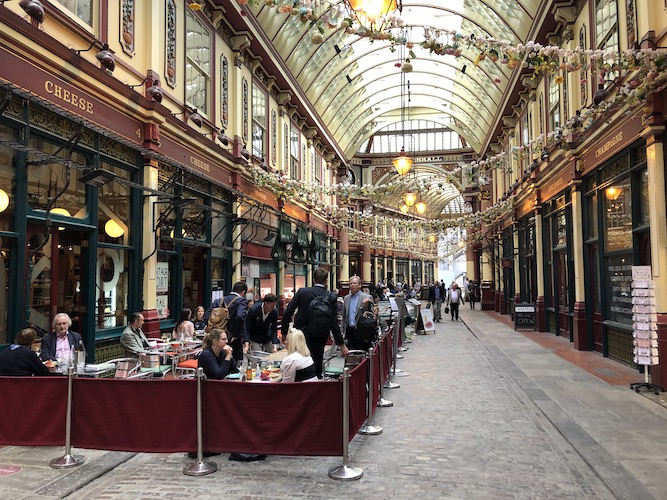Transport For London’s press release deployed the language of our times to valorise their “temporary traffic restrictions” along Bishopsgate and Gracechurch Street, heading down to the disabled London Bridge. The changes will, it said, “transform one of Central London’s major thoroughfares into a safer and less intimidating place that prioritises people walking and cycling”.
You don’t have to be a sceptic (as I am) about the revolutionary potential of road space reallocation to recognise that the future of the City of London could be a lot different from its recent past. How different, though? And in what ways?
Walking south down the east side of Bishopsgate, inspecting the hopeful blue Streetspace fencing, I passed a large, gold “22” attached to a pillar outside an office block. I couldn’t remember seeing it before. I crossed the road, looked up, and was astonished by the cloud-pricking spectacle of the truly enormous tower that has sprouted there.
It is on the site of what was going to be The Pinnacle, once expected to become the second tallest building in London after The Shard. That fell victim to the Great Recession and this giant has taken its place. “Twentytwo” is 33 feet shorter than The Pinnacle would have been, but it still looks like a lift shaft to the stars. Not yet open for business, it appears to be encased in bubble wrap. Will its 62 storeys ever be filled?
I met a friend at the M Bar in Leadenhall Market, established in 1321 at the heart of what was Roman London and now a celebrated Square Mile shopping and dining spot. I was following in the trail of Karl Mercer of BBC London, who reported from the M Bar the other week. Karl heard that business had become painfully, indeed laughably, slow.
That impression was in keeping with a word portrait of the City by Sky News business journalist Ian King. “Even before Boris Johnson announced a lockdown on 23 March, the Square Mile was beginning to depopulate,” he wrote. And now? “This pulsating financial village feels a shadow of its former self.” King added that, like the Prime Minister, he would “love to see people returning to the office and for the City’s working population to be back where it was pre-crisis.” But is this likely? “Not in the short-term,” concluded King.
And what about the longer-term? My elevenses friend is far more expert in these matters than I. He stressed that everyone is guessing about what might happen next. Not only are the behaviour of the virus and the date of the arrival of a vaccine impossible to reliably predict, so too are the assessments of Square Mile workers and employers of Covid-19 risk. For some, home working has been an unexpected pleasure; for others, taking their chances with corona is a far preferable option to going on being stuck at home all day long.
But, given all that, he thought it reasonable to imagine a Square Mile in which more people work in its offices than before, but for fewer days a week, once the current fear of public transport has receded. Flexible combinations of home and office labour could enable rotating, enlarged casts of staff. Some companies are already trying to offload office space, but there aren’t a lot takers. The alternative might be to make better use of the empty space, including by turning some of it into living quarters and amenities. Young City workers could have a flat “over the shop” as part of their employment deal, affordably housed at the very heart of the greatest city on Earth.
Who knows? But my friend underlined that there will already be people out there thinking about these problems and how to solve them. Eventually, some of them will back their solutions with cash.
It was gone 1:00 before we left. When I’d arrived in Bishopsgate just after 10.00, the area had felt very quiet and I had felt a little blue. But by now Leadenhall’s main avenue was quite lively. Most of the out-front dining tables were occupied. There were even a few a few blokes standing drinking beer. The City might be reeling, but reports of its death are surely premature.
OnLondon.co.uk exists to provide fair and thorough coverage of the UK capital’s politics, development and culture. It depends greatly on donations from readers. Give £5 a month or £50 a year and you will receive the On London Extra Thursday email, which rounds up London news, views and information from a wide range of sources. Click here to donate via Donorbox or contact davehillonlondon@gmail.com. Thanks.
